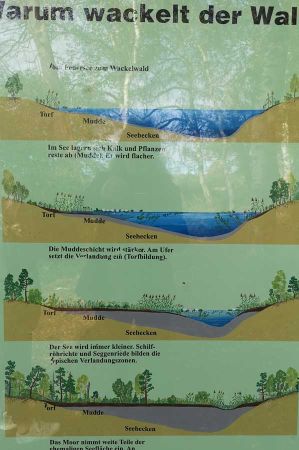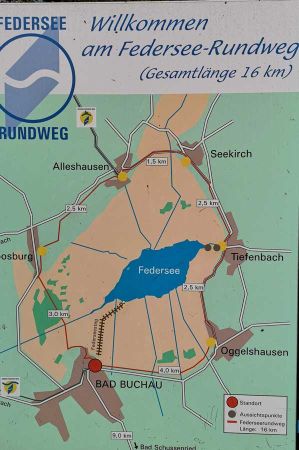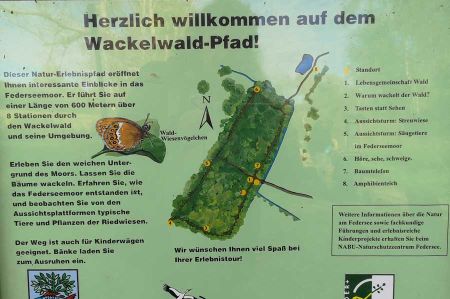Tour through the wobbly forest near Bad Buchau
- Written by Portal Editor
In life you always learn something new, at least if you keep an eye for your surroundings or receive appropriate advice, as in the case of the “wobbly forest” near Bad Buchau at Lake Federsee.
Our conversation with a customer on the subject of overnight accommodation for starlings at the Federsee was followed by the information whether we had also seen the wobbly forest, a natural phenomenon that can only be seen in a few places worldwide, because this moor phenomenon is in the immediate vicinity of the spa park on Outskirts of Bad Buchau. We had already reported several times about the Lake Federsee.
Stifts beer cooling with natural ice from the pond
At the time of the monastery and its brewery, the area of the pond on the Federsee was separated from the lake by a raised dam and was flooded annually via the Mühlbach until the last century. In winter the ice was broken out and taken on large, flat sledges to the ice cellar of the monastery brewery, where it was used to cool beer during the summer months. This type of ice extraction was far less dangerous than getting the ice out of the lake.
Ice pond grove with swaying ground
 Like the entire Federsee moor, the subsoil in the Eisweiherwäldchen consists of soft sediments that have been deposited in the Federsee during millennia. Just a 20 centimetre thick layer of matted plant roots make the soil / moor accessible. The ground sways with every step, and the vibrations are even transmitted to the trees. The valued walker can literally "let the trees shake". Hence the name Wackelwäldle.
Like the entire Federsee moor, the subsoil in the Eisweiherwäldchen consists of soft sediments that have been deposited in the Federsee during millennia. Just a 20 centimetre thick layer of matted plant roots make the soil / moor accessible. The ground sways with every step, and the vibrations are even transmitted to the trees. The valued walker can literally "let the trees shake". Hence the name Wackelwäldle.
After the ice pond lost its function as an ice supplier, it was reforested with spruce trees. However, pure spruce stands are not adapted to the living conditions in the bog and are therefore susceptible to diseases and pests. In the meantime, nature is allowed to run its course. After the spruce fell, a mixed forest, adapted to the living conditions, settled on the area, which is an interesting, diverse habitat for many animals. Typical woods are downy birch and pine, spruce, mountain ash and various types of willow. The dead trees in particular provide food and shelter for many specialized animals and plants. The trees stand on moorland - a result of the siltation of the post-glacial Federsee. This is why visitors can experience an extraordinary phenomenon here: the soft floor cushions with every step.
NABU set up a wobbly forest nature trail
 NABU has set up a nature experience path in the wobbly forest. At 8 stations at approx. 600 meters, nature lovers big and small can learn something about the origins of the Federsee moor. Animals and plants can be observed from lookout points. Benches and tables invite you to have a snack.
NABU has set up a nature experience path in the wobbly forest. At 8 stations at approx. 600 meters, nature lovers big and small can learn something about the origins of the Federsee moor. Animals and plants can be observed from lookout points. Benches and tables invite you to have a snack.
Participation stations invite you to get active and explore the forest with all your senses:
- Forest community
- Why does the forest wobble?
- Keys instead of seeing
- Streuwiese viewing platform
- Mammals observation tower in the Federsee moor
- Hear, see, be silent
- Tree phone
- Amphibious pond
TIP: In the NABU Nature Conservation Centre there is a fully packed nature exploration rucksack to borrow for a small fee.
Please read as well:
Swarm flyers with permanent sleeping places - the starlings
Bad Buchau at Lake Federsee - pile dwellings in the museum
-
 Natural phenomenon at Lake Federsee
Natural phenomenon at Lake Federsee
Natural phenomenon at Lake Federsee
Natural phenomenon at Lake Federsee
-
 Natural phenomenon at Lake Federsee
Natural phenomenon at Lake Federsee
Natural phenomenon at Lake Federsee
Natural phenomenon at Lake Federsee
-
 Natural phenomenon at Lake Federsee
Natural phenomenon at Lake Federsee
Natural phenomenon at Lake Federsee
Natural phenomenon at Lake Federsee
-
 Natural phenomenon at Lake Federsee
Natural phenomenon at Lake Federsee
Natural phenomenon at Lake Federsee
Natural phenomenon at Lake Federsee
-
 Natural phenomenon at Lake Federsee
Natural phenomenon at Lake Federsee
Natural phenomenon at Lake Federsee
Natural phenomenon at Lake Federsee
-
 Natural phenomenon at Lake Federsee
Natural phenomenon at Lake Federsee
Natural phenomenon at Lake Federsee
Natural phenomenon at Lake Federsee
-
 Natural phenomenon at Lake Federsee
Natural phenomenon at Lake Federsee
Natural phenomenon at Lake Federsee
Natural phenomenon at Lake Federsee
-
 Natural phenomenon at Lake Federsee
Natural phenomenon at Lake Federsee
Natural phenomenon at Lake Federsee
Natural phenomenon at Lake Federsee
-
 Natural phenomenon at Lake Federsee
Natural phenomenon at Lake Federsee
Natural phenomenon at Lake Federsee
Natural phenomenon at Lake Federsee
-
 Natural phenomenon at Lake Federsee
Natural phenomenon at Lake Federsee
Natural phenomenon at Lake Federsee
Natural phenomenon at Lake Federsee
-
 Natural phenomenon at Lake Federsee
Natural phenomenon at Lake Federsee
Natural phenomenon at Lake Federsee
Natural phenomenon at Lake Federsee
-
 Natural phenomenon at Lake Federsee
Natural phenomenon at Lake Federsee
Natural phenomenon at Lake Federsee
Natural phenomenon at Lake Federsee
https://www.alaturka.info/en/germany/baden-wuerttemberg/5172-tour-through-the-wobbly-forest-near-bad-buchau/amp#sigProId6ec567043f

